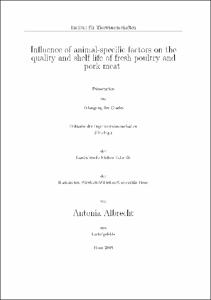Albrecht, Antonia: Influence of animal-specific factors on the quality and shelf life of fresh poultry and pork meat. - Bonn, 2019. - Dissertation, Rheinische Friedrich-Wilhelms-Universität Bonn.
Online-Ausgabe in bonndoc: https://nbn-resolving.org/urn:nbn:de:hbz:5n-56888
Online-Ausgabe in bonndoc: https://nbn-resolving.org/urn:nbn:de:hbz:5n-56888
@phdthesis{handle:20.500.11811/8029,
urn: https://nbn-resolving.org/urn:nbn:de:hbz:5n-56888,
author = {{Antonia Albrecht}},
title = {Influence of animal-specific factors on the quality and shelf life of fresh poultry and pork meat},
school = {Rheinische Friedrich-Wilhelms-Universität Bonn},
year = 2019,
month = dec,
note = {The objective of this thesis was the assessment of the influence of animal-specific factors on typical quality parameters and shelf life of fresh poultry and pork meat. The trials comprised different study designs to analyze the impact of the animal diet, production system, performance parameters, animal health and terminal sire genotype on the quality and shelf life of the end product. The quality analyses focused on physicochemical parameters, the nutritional value of the filets and biochemical muscle characteristics. The shelf life of the meat was determined by sensory as well as microbial investigations. Additionally, the purchase decision and the occurrence of meat failures such as pale soft and exudative meat as well as White Striping were investigated.
For poultry, the diet had a major impact on the meat quality, but not shelf life, of the breast filets. The meat quality was improved by the supplementation of different concentrations, but not sources, of methionine. However, the supplementation of methionine led to higher filet weights and a higher incidence of White Striping. Severe White Striping had a negative impact on the appearance and purchase decision. The investigation of different broiler production systems revealed an improved nutritional value, muscle characteristics and color of the filets produced in an alternative antibiotics-free husbandry system. The initial microbial quality or shelf life was not different between both production systems. Thus, an extensified and more sustainable production of poultry is possible without negative impacts on meat quality and shelf life.
For pork, an influence of performance parameters on meat quality as well as shelf life was observed. Besides breed and sex, specific quality parameters showed an effect on microbial shelf life. These factors were significantly influenced by the weaning age of the pigs. In contrast, the health status of the animals or antibiotic medication showed no significant effect on shelf life, even though animals with clinical findings displayed a tendency to a shortened microbial shelf life.
The optimization of terminal sire line genotype did not result in differences in the shelf life. But a higher susceptibility to stress was observed for one investigation group leading to lower pH-values, a higher drip loss and a higher incidence of PSE meat. Thus, optimization within the Piétrain breed still bears the risk of producing animals more susceptible to stress due to genetic characteristics and with implicit consequences for meat quality.},
url = {https://hdl.handle.net/20.500.11811/8029}
}
urn: https://nbn-resolving.org/urn:nbn:de:hbz:5n-56888,
author = {{Antonia Albrecht}},
title = {Influence of animal-specific factors on the quality and shelf life of fresh poultry and pork meat},
school = {Rheinische Friedrich-Wilhelms-Universität Bonn},
year = 2019,
month = dec,
note = {The objective of this thesis was the assessment of the influence of animal-specific factors on typical quality parameters and shelf life of fresh poultry and pork meat. The trials comprised different study designs to analyze the impact of the animal diet, production system, performance parameters, animal health and terminal sire genotype on the quality and shelf life of the end product. The quality analyses focused on physicochemical parameters, the nutritional value of the filets and biochemical muscle characteristics. The shelf life of the meat was determined by sensory as well as microbial investigations. Additionally, the purchase decision and the occurrence of meat failures such as pale soft and exudative meat as well as White Striping were investigated.
For poultry, the diet had a major impact on the meat quality, but not shelf life, of the breast filets. The meat quality was improved by the supplementation of different concentrations, but not sources, of methionine. However, the supplementation of methionine led to higher filet weights and a higher incidence of White Striping. Severe White Striping had a negative impact on the appearance and purchase decision. The investigation of different broiler production systems revealed an improved nutritional value, muscle characteristics and color of the filets produced in an alternative antibiotics-free husbandry system. The initial microbial quality or shelf life was not different between both production systems. Thus, an extensified and more sustainable production of poultry is possible without negative impacts on meat quality and shelf life.
For pork, an influence of performance parameters on meat quality as well as shelf life was observed. Besides breed and sex, specific quality parameters showed an effect on microbial shelf life. These factors were significantly influenced by the weaning age of the pigs. In contrast, the health status of the animals or antibiotic medication showed no significant effect on shelf life, even though animals with clinical findings displayed a tendency to a shortened microbial shelf life.
The optimization of terminal sire line genotype did not result in differences in the shelf life. But a higher susceptibility to stress was observed for one investigation group leading to lower pH-values, a higher drip loss and a higher incidence of PSE meat. Thus, optimization within the Piétrain breed still bears the risk of producing animals more susceptible to stress due to genetic characteristics and with implicit consequences for meat quality.},
url = {https://hdl.handle.net/20.500.11811/8029}
}






